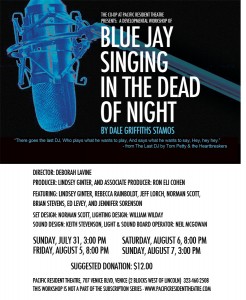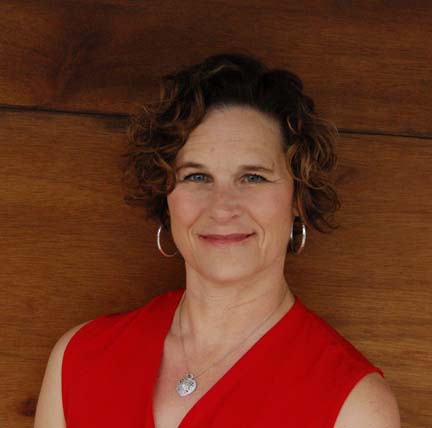
 Interview with Dale Griffiths Stamos
Interview with Dale Griffiths Stamos
What inspired you to write this play?
Although Blue Jay Singing in the Dead of Night is an entirely fictional piece, the idea is based on someone I knew who was a radio DJ who made it big in the 60’s and was demoted in the late seventies to the graveyard shift just as radio was going through a transition into a tighter format. Although my friend was an AM DJ, I found it much more interesting to explore the idea of what if this DJ had his biggest following during the heady days of the “Underground,” free form FM stations of the late 1960’s and early 1970’s where radio personalities ruled the airwaves. What would happen to such an “artist of the airwaves,” if forced to be like everyone else?
What is the play about?
See above. But generally it’s the story of a legendary disc jockey relegated, ten years later, to the graveyard shift in a radio world that’s drastically changed. It’s also the story of his relationship with his younger girlfriend whose songwriting career he has been managing, and what happens when she outgrows his tutelage and starts working with a talented fellow musician.
It’s called a play with music, what role does music play in this work?
Music plays several roles. First it is at the heart of who Jay Jarrell, “The Blue Jay” is, as what he chooses to play for his listeners on the radio, and how these pieces of music interweave with his sometimes lyrical, sometimes edgy commentary is all of one piece. That is why, when he moves to a station where there are set play lists, he is deprived of a major color in his artistic palette, (and as the play moves forward, he is deprived of many more.) The music played at the station also brings us into the era, that of the late sixties and early seventies, and what iconic songs were being created then. But there is also original music in this show, that I wrote (with additional music/lyrics by Skip Adams), which is the music played in scenes between Jay’s girlfriend, Laura, and the musician she’s working with, Steve. This is not a musical, people do not break into song. Instead these songs are a natural part of the scenes and how two musicians would get together and rehearse. The songs do, however, also add to the emotional complexity and content of the play.
What was the developmental process for the play?
This play has actually gone through a number of readings through the years at various theaters including, most recently, The Syzygy Theatre Group and Rogue achine Theatre. Each time I have rewritten and honed it. This is the first time, however, in which original music is being added. I actually started out in songwriting, and was inspired to bring the music in because of comments at one of the recent readings. I feel it opens up the play in a new and exciting way. We are presenting this at PRT as a developmental workshop (basic sets, lights, and the actors with scripts in hand) because we really want to focus on the words, acting, and music, to see how effectively it’s all working together. With a workshop of this sort, the audience, of course, plays a key role.
BIO
Dale Griffiths Stamos’s plays have been produced in the United States and abroad. She is a winner of the Heideman Award, the Jewel Box Theatre Award, and two time top ten winner of the Writer’s Digest Stage Play Competition. (Blue Jay Singing in the Dead of Night was one of those winners.) An evening of her one acts, Thicker Than Water, played recently in Santa Monica and starred the iconic Barbara Bain. Her newest full length: One White Crow, will open at Edgemar Center for the Arts in February of 2012. For more information go to: www.dalegriffithsstamos.com.
